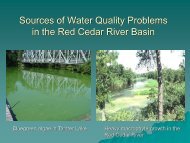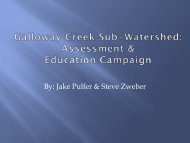Kirsten Cahow Scholtes, Eau Claire County - University of ...
Kirsten Cahow Scholtes, Eau Claire County - University of ...
Kirsten Cahow Scholtes, Eau Claire County - University of ...
- No tags were found...
You also want an ePaper? Increase the reach of your titles
YUMPU automatically turns print PDFs into web optimized ePapers that Google loves.
Conservation InYour Own BackyardBy: <strong>Kirsten</strong> <strong>Cahow</strong>-<strong>Scholtes</strong><strong>Eau</strong> <strong>Claire</strong> <strong>County</strong>Land Conservation DivisionSupervisor
Where does stormwater go?
Storm DrainGunk*Piped directly to Wetland,Lake or Stream* Gunk= sediment, nutrients, bacteria, organic matter, oil, heavy metals, etc.
Stormwater run<strong>of</strong>f is not treated.Runs <strong>of</strong>fimpervioussurfaceEnters stormdrain systemDischargedto river
Water emerges at high velocitythrough stormsewer systems
Flash Floods
Erosion
Sediment Delivered to waterway1 acre construction=75 acres cropland
… fills in spaces between rocksNo spaces for fish spawning No invertebrate habitat Spaces for fish to lay eggs Invertebrates can live & hide
Dealing with ImperviousSurfaces and Stormwater• Environmentally Friendly/Water-smart LawnCare• Directing downspouts to natural areas• Rain Gardens• Rain Barrels• Pervious pavers
Why go GREEN?: The Facts• Non-point run<strong>of</strong>f is the #1 threat to Wisconsin’swater, especially soil run<strong>of</strong>f• In Wisconsin up to 30% <strong>of</strong> all household trash isyard waste• Residential application <strong>of</strong> fertilizers can beexcessive if soil tests aren’t performed• A lawn <strong>of</strong>ten has less than 10% <strong>of</strong> the waterabsorption capacity <strong>of</strong> a natural woodland• Gas-powered landscape equipment account forover 5% <strong>of</strong> our urban air pollution
Benefits <strong>of</strong> EnvironmentallyFriendly Yard Care• Safer for children & pets• Environmental health• Water quality and quantity• Air quality• Save time and money• Healthier, more self-sufficient landscape
Choosing the right plants• Know your site conditions• Protect natural areas• Consider natives• Low maintenance plants• Energy conservation• Attracting wildlife• Property value and cost savings
Value <strong>of</strong> UsingNative PlantsDeeper roots -absorbs more waterUses no fertilizerUses little or no pesticidesEasy maintenance afterfirst yearDoes not require wateringafter establishment
Natives: It’s in the Roots
Landscaping with Natives
Designed & Installed by:Energyscapes
Oehme / van Sweden
Oehme / van Sweden
Keep your lawn healthy
Raise Mowing Height to 3”U <strong>of</strong> M Mowing-Height Studyphoto by: Mary Meyer
No Mow Lawn Mix (blend <strong>of</strong> fine fescues)Prairie Nurserywww.prairienursery.com
Think Before You Fertilize…
What does a few clippings inthe curb matter?
Grass Clippings & Fertilizers can containhigh levels <strong>of</strong> PhosphorusJune 25, 2007Lakeview Road
Franklin PondIncreased amounts <strong>of</strong> run<strong>of</strong>f with sediment, nutrients andpollutants can disrupt natural processesWe’re Dumping a Lot <strong>of</strong> Stuff In Our LakesDid you know: One quart <strong>of</strong> motor oil can contaminate 250,000 gallons <strong>of</strong> water
Increased amounts <strong>of</strong> run<strong>of</strong>f with sediment, nutrients and pollutants candisrupt natural processesWe’re Over-Fertilizing Our Lakes & StreamsComo Lake
Choose zero-phosphorus fertilizerIt’s the Law…by April 2010!Too much phosphorus promotes the rapid growth <strong>of</strong> weeds andalgae and decreases water clarity, <strong>of</strong>ten turning lakes green
Choose zero-phosphorus fertilizerOne pound <strong>of</strong> phosphorus in run<strong>of</strong>f can result in 500pounds <strong>of</strong> algae growth!If you follow the instructions on a bag <strong>of</strong> fertilizer containing phosphorus youmay be adding over 50# <strong>of</strong> phosphorus to a half-acre lot each year
Minimize Fertilizer and PesticidesImproper use can contribute to water quality problems!
Even better, stop usingtoxic products
Basics <strong>of</strong> Pest Control• Pest control starts with prevention• Identify the problem• Consider physical controls• Encourage biological controls• Use less toxic products• If pesticides are used, follow the directions• As a general rule: 90-95% <strong>of</strong> the insects onyour lawn and garden are NOT harmful
Properly dispose <strong>of</strong> householdhazardous wastesClean Sweep at WRR: May 9 th , July 11 th , Sept 12 th & Nov 14 thPharmaceutical Collection: May 16 th at <strong>Eau</strong> <strong>Claire</strong> EXPO Center
Other Yard Care Practices
What is composting?Using the natural process <strong>of</strong> decay tochange organic wastes into a valuablehumus-like material called compostGrass clippingsFood scrapsCompostLeaves
Compost• Reuse organic materials• Leaves• Lawn clippings• Other plant material• Recycle natural nutrients• Improve soil without chemicals• Produce rich humus for plants• Save money on chemical fertilizers
Mulch• Provides more uniform soiltemperature• Reduces soil erosion, and moistureloss• Improves soil structure• Reduces or eliminates weeds• Reduces soil-borne disease
Mulches• Synthetic• Plastic• Landscaping Fabric• Organic• Leaves• Straw• Wood chips• Paper Mulch
Conserve Water• Think Water-Wise• Know your site conditions• Water-friendly landscaping• Avoid over-watering-Asphalt does NOT grow• Use efficient irrigation methods• Proper scheduling <strong>of</strong> watering• Explore alternative methods <strong>of</strong>watering
Category 1: Minimum Input, Sunny Location- Generally will not be watered.- Will be fertilized once per year or less.- Will be mowed no more than once per week.- Where a more drought-tolerant lawn is desired.Grass Mix: Mixture <strong>of</strong> 50 to 60% common type Kentucky bluegrasses and 40 to 50%fine fescue. Include at least two varieties from Aquila, Monopoly, Nassau, Newport,Nugget, Park, Ram I, Rugby, South Dakota Certified, Sydsport, Touchdown, or othercommon Kentucky bluegrass. One or two varieties <strong>of</strong> fine fescue (sometimes listedon the seed label as creeping red fescue, Chewings fescue, or hard fescue) shouldalso be included.Category 2: Minimum Input, Partially Shady LocationInputs as in Category 1.Grass Mix: Seed with mixture <strong>of</strong> about 60% fine fescue grasses and 40% shadetolerant Kentucky bluegrass. Some <strong>of</strong> the better shade tolerant Kentucky bluegrassvarieties for Minnesota include Eclipse, Glade, Touchdown, Ram I, Nugget, andSydsport.U <strong>of</strong> Mn Extension,Mugaas & Pedersen
Build a Rain Garden
The Basics <strong>of</strong>Rain GardensHelps to protectand restore naturalhydrologyAllows rain tosoak into the groundIntercepts pollutants
Raingardens(Capturing Rainwater / Stormwater )Just like a regular landscape planting,but designed primarily to absorb rainwaterConcept - Gregg Thompson, Illustration - Taina Litwak, Animation - Ron Struss
uphillDown spoutuphillbermdownhill
Making a Raingarden1. Find the Right Location:Locate near a downspout, sidewalk, driveway – any place that producesrun<strong>of</strong>f (but at least 10’ away from nearby buildings with basements).Raingarden size should be about 10-15 % <strong>of</strong> the size <strong>of</strong> theimpervious area that flows to it.2. Create a Shallow Depression:Excavate a shallow (4-6” deep), flat-bottomed bowl to collect rainwaterand snowmelt. If needed, deeply loosen the soil below and add wellagedleaf-compost into this soil, to help encourage water to soak intothe ground. Add 2-3” depth <strong>of</strong> shredded wood mulch to cover thesoils in the raingarden area.3. Choose the Right Plants:Pick the ‘Right Plant for the Right Place’. Select plants (whetherperennials, shrubs and/or trees) that can thrive in periodic floodingand also periods <strong>of</strong> drought, in your site’s soil types.
PlantingDepressionBermPlymouth
Blue Flag IrisPussytoesYear 2
Attracts Birds & Butterflies
Attractive addition to property,enhancing beauty <strong>of</strong> community
Expo Center Rain Gardens
Half Moon Lake Rain Garden
Lake Wissota Rain Garden
Other <strong>Eau</strong> <strong>Claire</strong> Rain Gardens
Direct downspouts onto your lawnor landscaping, not hard surfaces
Why Rain Barrels?• It’s free water collected from your ro<strong>of</strong>.• May be practical where a rain garden isn’t• Rain water is usually s<strong>of</strong>t and free <strong>of</strong>dissolved minerals. This untreated water isgreat for your indoor plants, your gardenand lawn, or washing your car• Minimizes stormwater impacts
Mosquito – Pro<strong>of</strong> Inlets55 gallons eachCapture Water with Rainbarrels
OverflowOutletInletBuild Your Own Rainbarrel
Options for driveways and otherimpervious surfaces
NRCS-Iowa
Permeable Pavers‘Turf Block’Detroit Lakes, MN
Permeable Pavers‘Turf Block’Detroit Lakes, MN
Local pervious driveway





